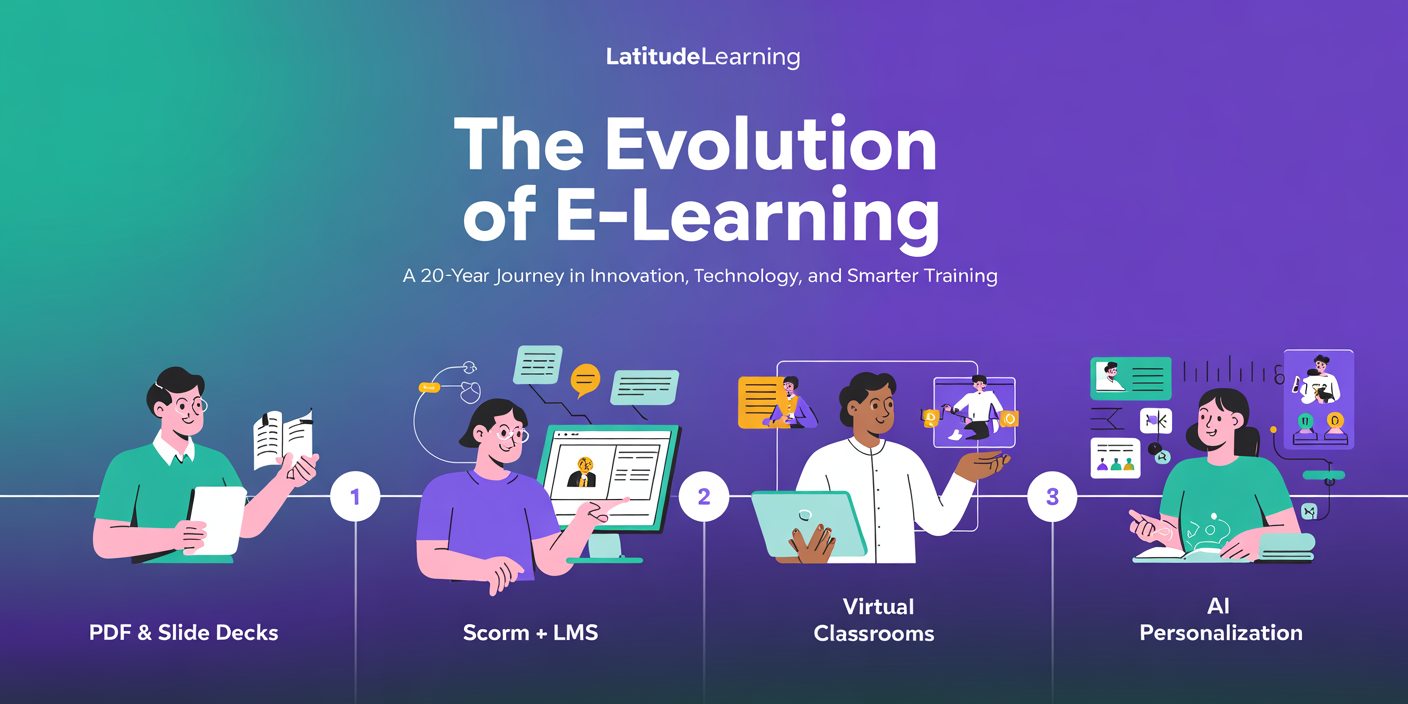
Let’s rewind to the early 2000s.
If you worked in a large organization or franchise network back then, chances are your first taste of “eLearning” was… a PDF. Maybe a slide deck uploaded to a company intranet. There were no interactive modules. No auto-tracking. Definitely no AI. You’d scroll through, maybe answer a few questions, click “Complete,” and that was that.
Fast forward to now, and we’ve got personalized learning paths, AI-generated course content, and entire virtual environments where people can actually learn by doing—with AR/VR simulations, real-time coaching, and role-specific content.
The change has been wild—and amazing to be a part of.
In the beginning, digital training was more about moving content online than making it better. Static PDFs and PowerPoint files were just digital versions of old manuals. Nothing was interactive, and there was zero personalization.
The big challenge? Engagement. Most employees (myself included back then) didn’t retain much from those early digital modules. There was no feedback, no checkpoints, and no way for managers to know if anyone actually learned anything.
But it was a start.
Things changed when SCORM came onto the scene. It sounds technical (because it is), but SCORM basically made it easier to track learner progress and standardize digital content. This is where Learning Management Systems (LMSs) started to take off.
With platforms like LatitudeLearning, enterprise organizations and franchise systems could:
This was huge. For large networks—think retail chains, healthcare systems, partner programs—training was finally scalable and manageable.
The LMS became more than just a content host. It became the backbone of workforce development.
As tech got better, bandwidth improved, and companies became more global, we started seeing more virtual classrooms and blended learning models.
That meant:
For people like me—who learn best by doing and asking questions in the moment—this was a game-changer. Plus, it gave organizations a way to stay connected with remote employees, franchisees, and partners without flying people around the world.
We saw training become more human again, even through screens.
In the last five to seven years, things have really taken off.
Smart Automation LMS platforms started doing things we once thought were impossible:
This is where learning went from “just in case” to “just in time.” Employees could get exactly what they needed—right when they needed it.
For large organizations, that means:
And it’s all happening during an era of explosive information growth. In fact, more than 90% of the world’s data has been generated in just the last two years alone .In 2025, the world is expected to create 175 zettabytes of data annually—up from 33 zettabytes in 2018.
Learning systems have had to evolve rapidly just to keep up.
Okay, now let’s talk about the cool stuff.
Augmented Reality (AR) and Virtual Reality (VR) have officially made their way into training. No, these technologies are not just for Silicon Valley startups.
Enterprise and Franchise companies are using VR to simulate customer interactions. Manufacturers are using AR headsets to walk technicians through complex repairs. Even hospitality brands are training new hires in virtual kitchens and guest scenarios.
We’re finally closing the gap between theory and practice. Learning is becoming physical, emotional, and real—even when it’s digital.
Let’s not forget: this journey hasn’t been smooth. There were some serious hurdles:
But here’s what I love: LMS providers like LatitudeLearning leaned in. They worked side-by-side with HR teams, training managers, franchise developers, and enterprise leaders to:
In the last 10 years, we’ve seen more innovation in training than in the previous two decades combined.
If you ask me (and a lot of analysts), the next wave is already forming:
And guess what? Organizations that invest in this now will lead tomorrow.
Training is no longer a check-the-box task—it’s a competitive advantage. Training builds culture and accelerates growth, and with the right LMS in place, it scales effortlessly across your entire workforce population—whether that’s 500 or 5,000 or or 500,000.
We’ve come a long way from PDFs. Are you as excited as we are to see what’s next? Sign up below to receive our weekly Training Insights Blogs on best practices, thought leadership, and extended enterprise training developments.